

Table of contents
- Why sand the lawn?
- Dose the sand precisely
- apply sand properly
- frequently asked Questions
The lawn is the focal point of the garden. Sanding the lawn can effectively influence its appearance. However, there are a few things to consider, because too much of it can also damage the green. Read here how much sand you should apply per m² when sanding the lawn.
Why sand the lawn?
A dense and lush green lawn needs loose and well-drained soil without waterlogging to grow. The top layer of soil should therefore always be 10 to 15 centimeters loose and airy. At very loamy and dense soils can weeds and moss quickly gain a foothold and displace the grass plants. Sanding the lawn can help here. The advantages of this measure are
- Improvement of water absorption, holding power and air circulation
- Improved cation exchange, i.e. accumulation of nutrients in the soil and delivery of these to the grass roots
- Prevention of waterlogging
- healthy root growth
- higher resilience of the lawn
- prevention of lawn diseases, weed and moss growth
- Elimination of bumps in the lawn
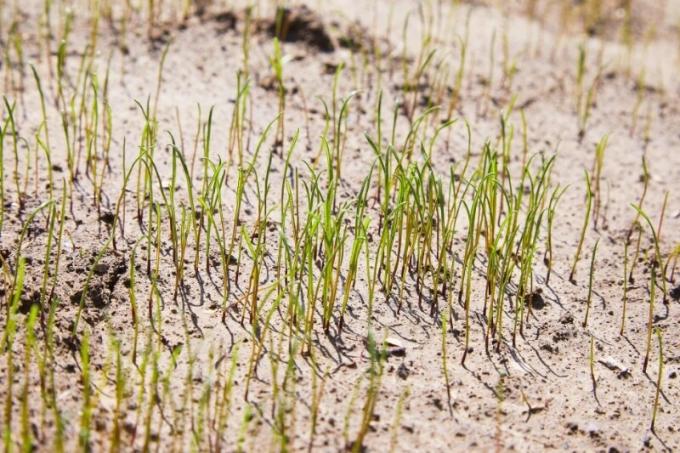
Besides this, sand can also be a good help in the Reseeding on bare spots be. The seed in this case is mixed with sand. This brings the following benefits
- easy deployment
- reduces bird feeding
- offers protection against dehydration and strong sunlight
A notice:
After sanding the lawn, patience is required. After three to five years, the first successes are visible, but only if you spread sand every spring.
Dose the sand precisely
Do not spread the sand indiscriminately on the lawn. Too much sand on the lawn causes major damage. The soil becomes thin and the lawn plants dry up as a result. How much sand you need to sand the lawn always depends on the existing soil type. Large amounts of sand are required for heavy, clayey and loamy lawns that are also heavily used. In short: The more compacted, clayey or loamy the soil is, the larger amounts of sand are required! A soil analysis can provide information about the condition of the soil. The first signs of heavily compacted soils are
- increased occurrence of thatch, moss, weeds
- bald spots
- brown-yellow blades of grass
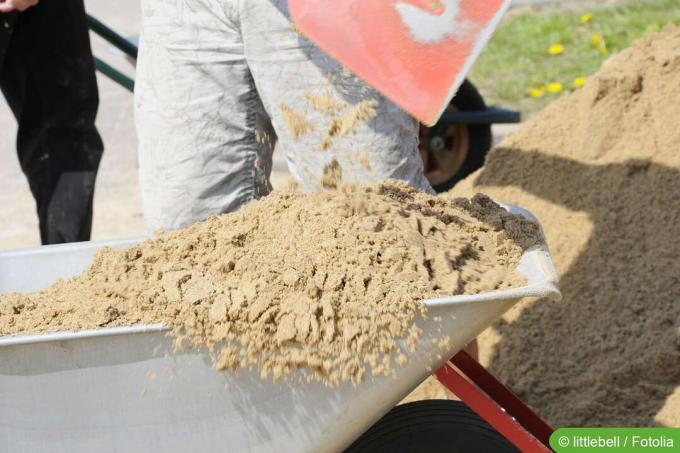
For soils in need, you should maximum 10 liters of sand per square meter, regardless of the type of sand. As a rule, three to five liters are usually sufficient. Rules of thumb are
- after scarifying (moss and mulch removal) 2 to 3 l/m²
- after aerating (lawn aeration) 3 to 5 l/m²
Then spread the sand one to two centimeters thick on the lawn. The grass plants must not be completely covered. The tips of the blades of grass must still be visible.
A notice:
If the soil is sandy, no additional sand is required. The already loose soil structure prevents waterlogging and the associated compaction of the soil.
apply sand properly
When sanding your lawn, it's important not only to know how much sand to apply, but also how to do it properly. However, before you can spread the sand, you must first carry out some preparatory work. Two weeks before this measure, the lawn is fertilized so that it has enough strength for the upcoming care measure. After that, do the following:
- Mow the lawn three inches high.
- Remove thatch by scarifying.
- Ideally, aerate afterwards.
- Distribute the sand evenly over the lawn. Either one spreader or use sanders. Application by hand with a shovel is also possible. Then spread the sand with the back of a rake or pull a lawn scraper flat over the area.
- Then water the lawn thoroughly so that the sand can get through the scarifying grooves or Ventilation holes flushed into the ground.
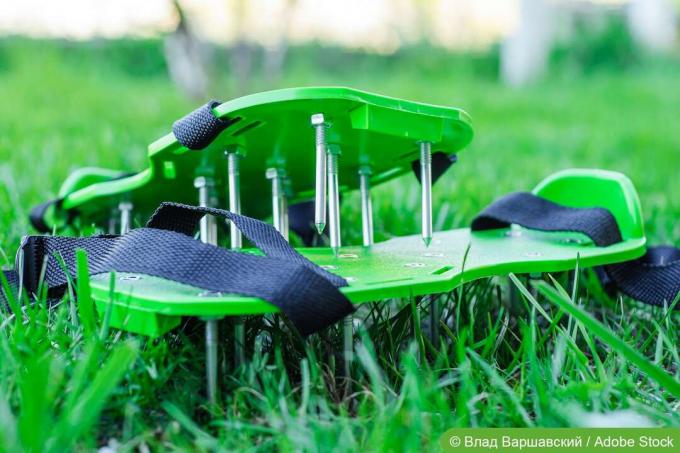
Tip:
A Aerating the lawn can increase the effect of sanding. Holes are made in the lawn using an aerating fork, spiked shoes or rollers. The sand that is then introduced results in much deeper soil aeration.
frequently asked Questions
In general, this measure should not be carried out during the summer months. During this time, the lawn is stressed enough by periods of heat. Sanding is optimal in the spring between April and May, when the grass plants begin to grow and temperatures that are too low are no longer to be expected. Sanding is still possible in autumn, but then no more hot spells should be approaching.
It always depends on the nature of the soil. Heavy and loamy soils should be sanded once a year in spring and possibly again in autumn. The situation is different with normal, well-drained and little-used lawns. Here it is sufficient to sand the lawn every two to three years.
The use of quartz sand with a grain size of 0.5 to 1.5 mm has proven itself. It is washed, i.e. free of attachments such as silt or clay, and contains no calcium compounds. In addition, it has a fine and round-grained shape. This allows it to spread well on the turf and in the ground. Under no circumstances should sharp-edged sand be used, as it prevents the grass plants from branching out in the ground.
Yes and no. Small amounts of clay and silt are usually present in play sand. These parts are not very good for the lawn because the sand can clump together quickly. Playing sand should therefore not necessarily be the first choice. However, if it is washed and does not contain any additional components such as clay, etc., then it can be used.
 Mirko
Mirko
Learn more about lawn care

Overseed the lawn without scarifying?
Which hobby gardener doesn't dream of a dense, lush green lawn? Bald spots not only look unsightly, they also encourage weed growth. But can you overseed a lawn without scarifying it first?

Recognize and fight couch grass successfully | 10 tips
Couch grass is one of the most stubborn weeds. However, there are also differences here, because not every species becomes a problem in the garden. However, if the creeping or common couch grass is up to mischief, you can take action against it with perseverance and the right techniques.
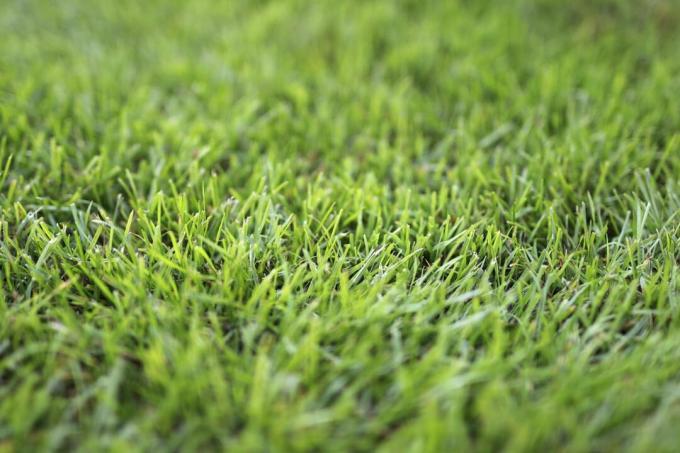
Iron fertilizer: the right use in the lawn
Iron fertilizer supplies the lawn and works against moss. However, it has to be used correctly. Therefore, observe the following tips to achieve optimal results for the grass plants and to avoid damage to the meadow.

Does coffee grounds help against clover in the lawn?
Clover in the lawn is a nuisance that many garden owners struggle with. Lawns, which in some cases are interspersed with numerous nests, are often affected. As an alternative to chemical agents, many wonder whether coffee grounds are effective against weeds.
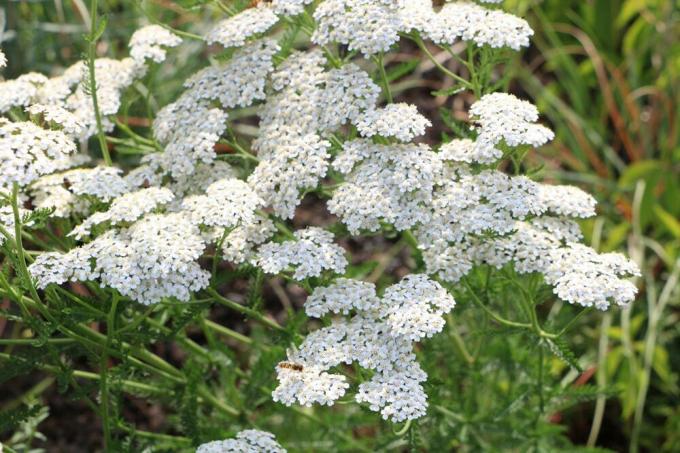
Yarrow in the lawn | How do I get rid of yarrow?
There is no question that yarrow is one of the best-known medicinal herbs. It helps against colds and is used for skin diseases and gynecological problems. On the manicured lawn, she is seen as a troublemaker. How do you get rid of them? Are there effective alternatives to the chemical club?
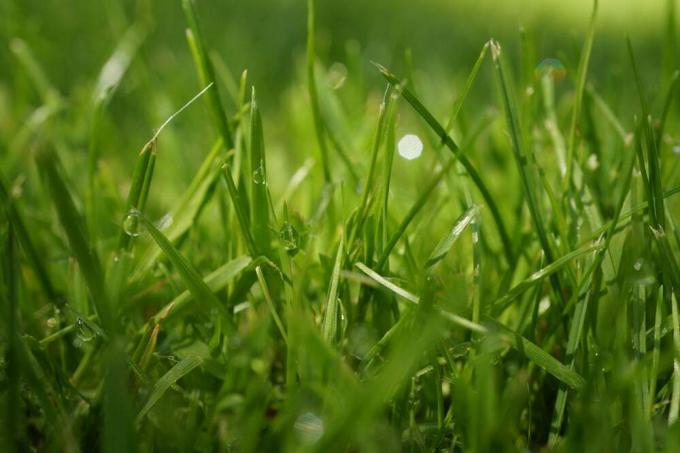
Which lawn fertilizer to use in spring? 9 tips for spring
The winter months mean stress for the lawn. In the spring he therefore has to recover from the cold season and recharge his batteries. The gift of a spring fertilizer is therefore essential. Here is which one is suitable and what else needs to be done.
